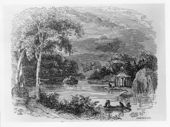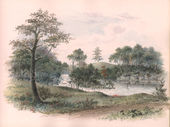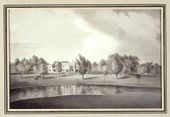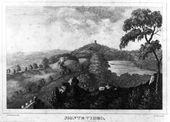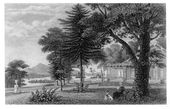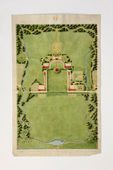Lake
See also: Pond
History
The terms lake, pond, and, to a lesser extent, pool, were used to describe still-water features in garden settings in American landscape writing. Distinctions between them were not consistently made in dictionaries, treatises, or usage examples, and several of these sources used them synonymously. William Bartram, for instance, used the terms “lake” and “pond” interchangeably when describing Lake George, Georgia, in 1791. Nehemiah Cleaveland, in his 1847 guide to Green-Wood Cemetery in Brooklyn, New York, was also undecided as to whether the bodies of water of “different size and shape” were either small lakes or ponds. A. J. Downing (1849) suggested that the terminology differed from British usage because of the abundance and scale of America’s natural waterways: “many a beautiful, limpid, natural expanse which in England would be thought a charming lake, is here simply a pond.” The first American edition of the Encyclopaedia (1798) stated flatly that “A pool and a pond are the same.” Noah Webster (1828) was clear in his distinction between a pond and a lake, with the latter being larger, and between a pond and a pool, but even Webster noted that the term “pool” was “used by writers with more latitude.” He also defined pool as “a small collection of water in a hollow place, supplied by a spring, and discharging its surplus water by an outlet. It is smaller than a lake, and in New England is never confounded with pond or lake. It signifies with us, a spring with a small bason or reservoir on the surface of the earth.”[1]

The term “lake” generally connoted a larger-scale feature than that of a pool or pond, although, as noted above, the term “pond” was used interchangeably with that of “lake” in several descriptions. As indicated in the Horticultural Register (1836), the term “lake” signified a dignity that the smaller scale of a pond could not match. Lakes fulfilled a variety of functions in the garden, serving, for example, as a habitat for fish and water fowl, a source of ice and irrigation water, and, in garden design, a natural mirror and animating element. Their scale made them suitable for swimming and boating, as evidenced by the boating and bathing houses found along the shores of many.
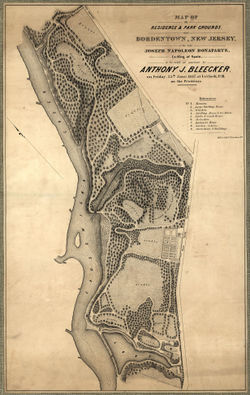
Lakes in American garden settings were usually created by enlarging natural water features or by damming water courses. Existing lakes were incorporated into a landscape design by the addition of plantings, mounds, garden buildings, or bridges, such as those depicted at Monte Video and Blithewood [Fig. 1].[2] Lakes could also be created by enclosing part of a river, as described by A. J. Downing in his plan for a “Mansion residence, laid out in a natural style,” and seen in the plan for Point Breeze [Fig. 2]. Most of the American examples of lakes as garden elements date from the 19th century, and were found in the largest and most elaborate gardens of their time. As Downing pointed out in 1849, this exclusivity was due to the abundance of natural waterways in America, which made artificial lakes superfluous in many settings. In addition, the cost of undertaking such massive earth-moving made them impractical for most American garden owners.
Bodies of standing water, whether called lakes, ponds, or pools, provided many of the same visual effects, and writers praised the associations of coolness and the animating quality that water brought to a garden.[3] As Downing noted, animation might come from the sparkle of the reflecting sun, the movement of wind on the water, or from the sound of a fountain or a stream feeding the pond. Water was prized, as Abercrombie (1817) observed, as a natural mirror reflecting the surrounding vegetation or, as at the carefully placed pond at Monticello and in a painting of an unknown site [Fig. 3], the house itself. Bodies of water not only sustained fish for sport and food, but, as Humphry Repton (1803) advised, they also attracted waterfowl and other animals and thus enhanced visual and aural interest of the garden. Downing (1847) praised the effect of contrasting water features, such as the rush of the waterfall at Blithewood, on the Hudson, juxtaposed with the still waters of the lake, “so full of the spirit of repose.”
—Elizabeth Kryder-Reid
Texts
Usage
- Bartram, William, 1791, describing Lake George, GA, and settlements of the Muscogulge and Cherokee Indians (1791; repr., 1928: 101–2, 407)[4]
- “At about fifty yards distance from the landing place, stands a magnificent Indian mount. . . But what greatly contributed towards completing the magnificence of the scene, was a noble Indian highway, which led from the great mount, on a straight line, three quarters of a mile, first through a point or wing of the orange grove, and continuing thence through an awful forest of live oaks, it was terminated by palms and laurel magnolias, on the verge of an oblong artificial lake, which was on the edge of an extensive green level savanna. . . The glittering water pond played on the sight, through the dark grove, like a brilliant diamond, on the bosom of the illumined savanna, bordered with various flowery shrubs and plants. . .
- “From the river St. Juans, Southerly, to the point of the peninsula of Florida, are to be seen high pyramidal mounts with spacious and extensive avenues, leading from them out of the town, to an artificial lake or pond of water; these were evidently designed in part for ornament or monuments of magnificence, to perpetuate the power and grandeur of the nation.”
- Strickland, William, November 1794, describing Connecticut (1971: 208)[5]
- “Throughout all Connecticut many ponds as called here, or as we should call them according to the scale of our own country, Lakes, are scattered in the low grounds or hollows among the Hills from which flow most of the lesser rivers, and streams, they are in length and breadth various from a mile to several; they add a beautiful feature, to a beautiful country, and considerable accomodation to those who reside near them or whose property they may be.”
- Silliman, Benjamin, 1819, describing Monte Video, property of Daniel Wadsworth, Avon, CT (1824: 11–12, 26)[6]
- “The space or hollow caused by the absence of the ridge, or what may be very properly called the back bone of the mountain, is occupied by a deep lake, of the purest water, nearly half a mile in length, and somewhat less than half that width. . . The ground is gently undulating, bounded on the west by the precipice which overlooks the Farmington valley, and inclining gently to the east, where it is terminated by the fine margin of trees, that skirt the lake. . .
- “From this place [the summit] you have a view of the lake, of the boat at anchor on its surface, gay with its streamers and snowy awning: of the white building at the north extremity of the water, and, (rising immediately above it,) of forest trees and bold rocks, intermingled with each other, and surmounted by the Tower. . .
- “The beautiful crystal lake is on the top of the same lofty greenstone ridge, and within a few yards of the house; it pours its superfluous waters in a limpid stream, down the mountain’s side, and affords in winter the most pellucid ice that can be imagined.”
- Bryant, William Cullen, August 25, 1821, in a letter to his wife, Frances F. Bryant, describing the Vale, estate of Theodore Lyman, Waltham, MA (1975: 108)[7]
- “He took me to the seat of Mr. Lyman. . . It is a perfect paradise. . . In front of the house, to the south was an artificial piece of water winding about and widening into a lake, with a little island of pines in it, an elegant bridge crossing it, and swans swimming on the surface.” [Fig. 4]
- B., J., October 1, 1836, “Horticulture in Maine” (Horticultural Register 2: 385)[8]
- “In China, there is a beautiful pond seven or eight miles in length, which ought to be dignified with the title of lake. Its shores are mostly lined with well cultivated farms: it is enriched with islands and capes, and affords some fine scenery.”
- Cleaveland, Nehemiah, 1847, describing Green-Wood Cemetery in Brooklyn, NY (1847: 14)[9]
- “Various small lakes, or ponds of different size and shape, embellish the grounds; and some of these have been so cleansed, deepened, and banked, as to present a pleasant feature in this wide-spread extent of forest loveliness—this ground of hallowed purpose.”

- Downing, Andrew Jackson, October 1847, describing Montgomery Place, country home of Mrs. Edward (Louise) Livingston, Dutchess County, NY (Horticulturist 2: 157–59)[10]
- “THE LAKE.
- “That shadowy path, that steals away so enticingly from the neighborhood of the cataract, leads to a spot of equal, though a different kind of loveliness. Leaving the border of the stream, and following it past one or two distracting points, where other paths, starting out at various angles, seem provokingly to tempt one away from the neighborhood of the water, we suddenly behold, with a feeling of delight, THE LAKE.
- “Nothing can have a more charming effect than this natural mirror in the bosom of the valley. It is a fine expansion of the same stream, which farther down forms the large cataract. Here it sleeps, as lazily and glassily as if quite incapable of aught but reflecting the beauty of the blue sky, and the snowy clouds, that float over it. On two sides, it is overhung and deeply shaded by the bowery thickets of the surrounding wilderness; on the third is a peninsula, fringed with the graceful willow, and rendered more attractive by a rustic temple; while the fourth side is more sunny and open, and permits a peep at the distant azure mountain tops. . . [Fig. 5]
- “The stream here emerges from a dark thicket, falls about twenty feet, and then rushes away on the side of the peninsula opposite the lake. Although only separated by a short walk and the mass of cedars on the promontory, from the lake itself, yet one cannot be seen from the other; and the lake, so full of the spirit of repose, is a perfect opposite to this foaming, noisy little waterfall.”
Citations
- Loudon, J. C. (John Claudius), 1826, An Encyclopaedia of Gardening (1826: 1010–11)[11]
- “7217. To imitate lakes, rivers, or rills, and their accompaniments, is the object of landscape-gardening; and of each of these natural characters we shall remark the leading circumstances in the originals and the imitations. . .
- “7220. A beautiful lake, or part of a circuitous body of water, considered as a whole, will be found to exhibit a form, characterised by breadth rather than length; by that degree of regularity in its outline as a whole, which confers that, which, in common language, is called shape; and by that irregularity in the parts of this outline, which produces variety and intricacy. Supposing the situation to be fixed on for the imitation of a lake. . . the artist is to consider the broadest and most circuitous hollow as his principal mass or breadth of water, and which he will extend or diminish according to the extent of aquatic views the place may require. From this he may continue a chain of connected masses of water, or lakes of different magnitudes and shapes, in part suggested by the character of the ground, in part by the facilities of planting near them, and in part by his own views of propriety and beauty. The outline of the plan of the lake is to be varied by the contrasted position of bays, inlets, and smaller indentations, on the same principles which we suggested for varying a mass of wood.”
- Webster, Noah, 1828, An American Dictionary of the English Language (1828: 2:n.p.)[12]
- “LAKE, n. [G. lache, a puddle; Fr. lac; L. lacus; Sp. It. lago; Sax. luh; Scot. loch; Ir. lough; Ice. laugh. A lake is a stand of water, from the root of lay. Hence L. lagena, Eng. flagon, and Sp. laguna, lagoon.]
- “1. A large and extensive collection of water contained in a cavity or hollow of the earth. It differs from a pond in size, the latter being a collection of small extent; but sometimes a collection of water is called a pond or a lake indifferently.”

- Downing, Andrew Jackson, 1849, A Treatise on the Theory and Practice of Landscape Gardening (1849; repr., 1991: 116, 349, 351)[13]
- “A fine natural stream or rivulet, which ran through the estate, has been formed into a handsome pond, or small lake, f, which adds much to the interest of the grounds. . .” [Fig. 6]
- “the possession of a small lake, well stocked with carp, trout, pickerel, or any other of the excellent pond fish, which thrive and propagate extremely well in clear fresh water, is a real advantage which no one will undervalue. . .
- “Lakes or ponds are the most beautiful forms in which water can be displayed in the grounds of a country residence.*They invariably produce their most pleasing effects when they are below the level of the house; as, if above, they are lost to the view, and if placed on a level with the eye, they are seen to much less advantage. We conceive that they should never be introduced where they do not naturally exist, except with the concurrence of the following circumstances. First, a sufficient quantity of running water to maintain at all times an overflow, for nothing can be more unpleasant than a stagnant pool, as nothing is more delightful than pure, clear, limpid water; and secondly, some natural formation of ground, in which the proposed water can be expanded, that will not only make it appear natural, but diminish, a hundred fold, the expense of formation.
- “*[f.n.] Owing to the immense scale upon which nature displays this fine element in North America, every sheet of water of moderate or small size is almost universally called a pond. And many a beautiful, limpid, natural expanse, which in England would be thought a charming lake, is here simply a pond. The term may be equally correct, but it is by no means as elegant.”
Images
Inscribed
J. C. Loudon, The imitation of a lake, in An Encyclopaedia of Gardening, 4th ed. (1826), 1010, fig. 696.
Miller & Co., Map of the residence & park grounds, near Bordentown, New Jersey: of the late Joseph Napoleon Bonaparte, ex-king of Spain, 1847. A lake is indicated in the lower portion of this plan.
Anonymous, “The Lake,” Montgomery Place, in A. J. Downing, ed., Horticulturist 2, no. 4 (October 1847): 158, fig. 27.
Anonymous, “Plan of a Mansion Residence, laid out in the natural style,” in A. J. Downing, A Treatise on the Theory and Practice of Landscape Gardening, 4th ed. (1849), 115, fig. 25. A lake is indicated at “f.”
Associated
Alexander Jackson Davis, Blithewood looking towards Montgomery Place, n.d. The Alexander Jackson Davis Sketchbook, c. 1830–50.
Alexander Jackson Davis, View in Grounds at Blithewood, Seat of Robt. Donaldson, Dutchess Co. Hud[son]. riv[er]. N.Y., 1840.
Alexander Jackson Davis, “Montgomery Place,” in A. J. Downing, ed., Horticulturist 2, no. 4 (October 1847): pl. opp. 153.
Alexander Jackson Davis, “View in the Grounds at Blithewood,” in A. J. Downing, A Treatise on the Theory and Practice of Landscape Gardening, 4th ed. (1849), frontispiece.
Attributed
Notes
- ↑ Noah Webster, “Pool” entry, An American Dictionary of the English Language (New York: S. Converse, 1828), n.p., view on Zotero.
- ↑ Fig. 1 is a preparatory sketch for “The Lake at Montgomery Place," view image.
- ↑ A. J. Downing, A Treatise on the Theory and Practice of Landscape Gardening, 4th ed. (New York: G. P. Putnam, 1849), 348, view on Zotero.
- ↑ William Bartram, Travels through North and South Carolina, Georgia, East and West Florida, ed. Mark Van Doren (New York: Dover, 1928), view on Zotero.
- ↑ William Strickland, Journal of a Tour in the United States of America, 1794–1795, ed. J. E. Strickland (New York: New-York Historical Society, 1971), view on Zotero.
- ↑ Benjamin Silliman, Remarks Made on a Short Tour between Hartford and Quebec, in the Autumn of 1819 (New Haven, CT: S. Converse, 1824), view on Zotero.
- ↑ William Cullen Bryant, The Letters of William Cullen Bryant, ed. William Cullen II Bryant and Thomas G. Voss (New York: Fordham University Press, 1975), view on Zotero.
- ↑ J. B., “Horticulture in Maine,” Horticultural Register, and Gardener’s Magazine 2 (October 1, 1836): 380–86, view on Zotero.
- ↑ Nehemiah Cleaveland, Green-Wood Illustrated (New York: R. Martin, 1847), view on Zotero.
- ↑ Alexander Jackson Downing, “A Visit to Montgomery Place,” Horticulturist and Journal of Rural Art and Rural Taste 2, no. 4 (October 1847): 153–60, view on Zotero.
- ↑ J. C. (John Claudius) Loudon, An Encyclopaedia of Gardening; Comprising the Theory and Practice of Horticulture, Floriculture, Arboriculture, and Landscape-Gardening, 4th ed. (London: Longman et al., 1826), view on Zotero.
- ↑ Noah Webster, An American Dictionary of the English Language, 2 vols. (New York: S. Converse, 1828), view on Zotero.
- ↑ A. J. [Andrew Jackson] Downing, A Treatise on the Theory and Practice of Landscape Gardening, Adapted to North America, 4th ed. (1849; repr., Washington, DC: Dumbarton Oaks Research Library and Collection, 1991), view on Zotero.




